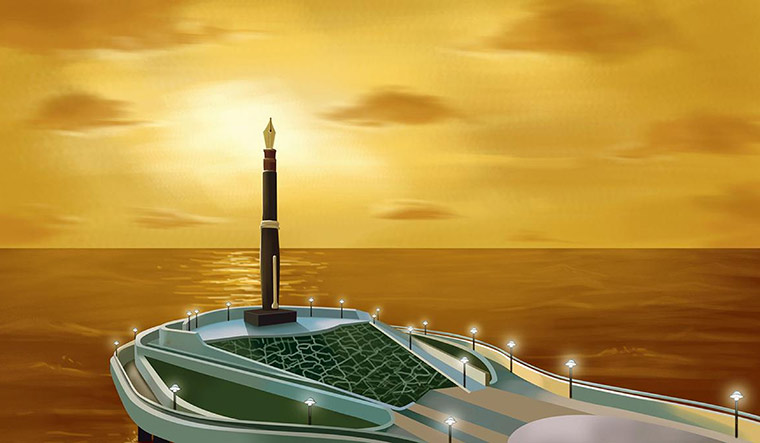ON JUNE 3, 1980, a few days after his DMK lost the assembly elections to M.G. Ramachandran’s AIADMK, M. Karunanidhi addressed a public meeting on the Marina beach in Chennai. “Thamizhargaley, Thamizhargaley, neengal yennai kadalil thooki yerinthalum naan kattumaramaga thaan midhapean. Neengal athil yeari payanam seyyalam; naan kavizhndhu vida maatten [If you throw me into the ocean, I will only float like a catamaran. You can sail on it safely; I will not capsize],” he said.
In a nod to Karunanidhi’s catamaran reference, an offshore memorial is in the works―a 134ft-tall pen-shaped structure as an ode to the author, poet and scriptwriter in him. The state’s public works department plans to build the memorial in the Bay of Bengal, 360m from the shoreline. The project, which involves a landscaped garden and a pedestrian bridge, is expected to cost Rs81 crore and will be spread over two acres on land and in sea. The 650m-long bridge―290m over land and 360m over sea―will connect Karunanidhi’s memorial-in-the-making on Marina beach and the pen monument. A part of the bridge will have latticework.
But the memorial has already run into rough weather, with environmentalists raising concerns and opposition parties questioning the need for the project. The public hearing on January 31 saw a heated exchange between members of the DMK and the Naam Thamilar Katchi (NTK). A public hearing is held to gather citizens’ opinion ahead of the project’s environmental clearance as it falls under the Coastal Regulation Zone (CRZ). At the hearing, NTK chief Seeman said he would demolish the statue if it were constructed in the sea. Opposition leader Edappadi K. Palaniswami asked why the money spent on the memorial could not be directed towards education.
Environmentalists, meanwhile, pointed out that an offshore memorial could spell ecological disaster. “The Marina beach by itself is a monument,” said G. Sundarrajan of Poovulagin Nanbargal, an NGO. He said that environmentalists were not opposed to the memorial per se, but to it being built at the cost of the coastal environment.
The memorial requires clearances from the National Coastal Zone Management Authority and the Union environment ministry. Until 2015, the Union government, under the CRZ rules, did not permit any such construction in the sea. But the rules were tweaked to allow the Chhatrapati Shivaji Maharaj memorial off the Mumbai coast in the Arabian Sea; the pen memorial is modelled on the Shivaji statue. However, as per the 2018 notification of the CRZ rules, the exemption permitting construction of memorials and monuments applies only to the CRZ IVA areas (from the low tide line up to 12 nautical miles on the seaward side). Parts of the pen memorial, including the lattice walkway, fall under CRZ IVA, CRZ II (developed areas up to or close to shoreline) and CRZ 1A (comprising environmentally sensitive areas like mangroves, coral reefs, turtle nesting grounds). “The proposal should have been rejected at the pre-appraisal stage itself on legal grounds,” said Sundarrajan.
 An artist’s impression of the memorial | PTI
An artist’s impression of the memorial | PTI
One of the main concerns raised by environmentalists is that the memorial will affect the nesting ground of Olive Ridley turtles, who lay eggs about 50m from the high tide line along Chennai’s coastline. Activists said that the memorial would disturb the path the turtles take to their nests and affect conservation efforts. As per the Environmental Impact Assessment (EIA) report prepared by the Tamil Nadu Pollution Control Board (TNPCB), no aquatic species were found at the proposed project site. But environmental activist Nityanand Jayaraman debunked the claim, saying the marine survey was carried out between May and July of 2021, whereas the nesting season for turtles is between December and March. He added that the shore currents were very powerful at Marina, causing constant changes to the shoreline and the beach. “The EIA report has not taken into account the shoreline currents,” he said.
The report also stated that the memorial did not fall in the main fishing routes and therefore would not affect fishing activities. According to Jayaraman though, fishermen from Urur Kuppam, the fishing hamlet near Marina beach, caught 50kg prawns per day between December and March 2022 in the said area. And the Cooum estuary, which is part of the project site, has traditionally been a breeding ground for prawns and other fishes. “This is the place where we get the best prawns,” said Shanmugam, a fisherman from Urur Kuppam. “The memorial will only spoil our livelihood.”
Moreover, the construction of the memorial would involve dredging and land reclamation. “This will lead to sea erosion,” said Jayaraman. “At least 43 per cent of Tamil Nadu’s coast faces sea erosion.”
However, all these concerns were not heard during the public hearing. DMK members instead raised slogans against the critics of the memorial. The party mouthpiece―Murasoli―in its February 3 editorial said that those who opposed the pen memorial had no guts to take on the Union government’s Indian Marine Fisheries Bill, which, according to the newspaper, crushes fishermen.
While speaking at a marriage function, Chief Minister M.K. Stalin defended the project, saying that Karunanidhi’s pen changed the destiny of Tamils. “His pen scripted the manual for the Dravidian model of governance in Tamil Nadu,” he said.
The DMK government, however, insisted that it would begin work on the memorial only after getting the required clearances. Meanwhile, according to the minutes of the public hearing released by the TNPCB on February 20, more than 60 per cent of the participants supported the project. The plot only thickens.


